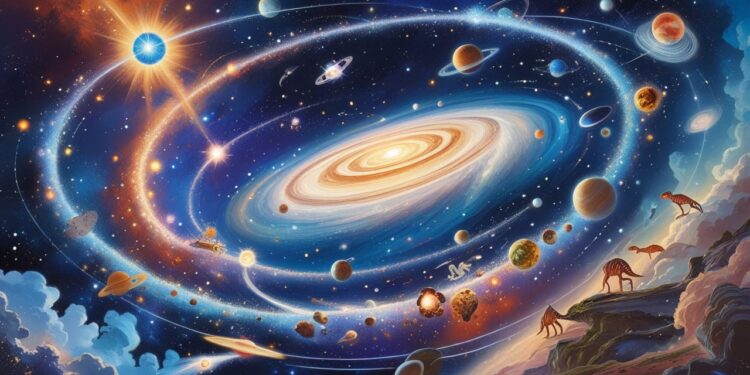The Ultimate Guide to the Universe: From the Big Bang to Today
The history of the universe is a story of transformation, over billions of years from the life of the cosmos at the present time to its earliest beginnings. Here is a look at the most significant events that have molded the cosmos, from the moment of its creation to the present day.
(1) The Big Bang: Creation Of The Universe (13.8 Billion Years Ago)
The Big Bang is the starting point for everything— space, time, matter and energy. It happened some 13.8 billion years ago. The universe was drastically warmer and denser at the beginning in a singular form known as singularity. The expansion kicked into high gear, the universe began to cool, and fundamental particles, such as protons, neutrons and electrons, were able to coalesce.
Key Events:
- Inflation: The universe inflated tremendously in the first tiny fraction of a second, growing faster and faster.
- Matter Formation: As the universe cooled, quarks joined together to form protons and neutrons, which in turn formed atoms.
(2) Formation of the First Elements or Nucleosynthesis (3–4 Minutes after the Big Bang)
In a few minutes after the Big Bang, the universe had cooled to the point where nuclear fusion took place. This created the universe’s first elements: mostly hydrogen and helium, with a little lithium. Those elements were the basis and building blocks of stars and galaxies.
(3) The Dark Ages: No Light (380,000 Years After the Big Bang)
After the formation of first atoms, the universe entered the so-called “Dark Ages”. There was no light at that time, he said, because the universe was teeming with neutral hydrogen gas, which absorbed radiation. But the seeds of light to come were being sown as these hydrogen atoms started to clump together under the influence of gravity.
(4) The Reionization Epoch: Generation of First Stars (400 Million Years after Big Bang)
Over time, the universe warmed up, and the first stars and galaxies formed. This epoch, which physicists refer to as reionization, was the time when clouds of electrified hydrogen plasma formed, making the universe transparent and finally allowing light to roam free through space. This ends the Dark Ages and the Cosmic Dawn for visible light begin.
(5) Formation of galaxies and new structures (1 billion years after the Big Bang)
When stars formed and started to clump, galaxies arose. The first galaxies were small, misshapen and less organized than the large spiral galaxies we see today. In time, these galaxies amalgamated together into larger galaxies and ignited star-building string reactions that ultimately produced more complicated systems.
Key Events:
· Formation of Galaxies: Building-up of galaxies from clouds of hydrogen and helium and from stars.
· Supernovae and Black Holes: Exploding stars, or supernovae, disperse elements such as carbon and oxygen into the cosmos, adding to the universe’s reservoir of the stuff from which stars and planets are made.
(6) The Milky Way and Our Solar System (13 Billion Years Ago)
Our Milky Way galaxy started forming about 13 billion years ago. Our Solar System formed around 4.6 billion years ago within a molecular cloud of gas and dust that collapsed under its own gravity. The Sun coalesced at the middle, and everything else fell into place as planets, including Earth.
(7) Origins of Life on Earth (Approximately 3.8 Billion Years Ago)
This water formed in an environment that was initially inhospitable for life, but cooled enough to allow for liquid water, a requirement in the formation of life. The first life forms were single-celled.
(8) The Emergence of Complex Life and the Cambrian Explosion (541 Million Years Ago)
Approximately 541 million years ago, during the Cambrian Explosion, complex, multicellular organisms first appeared. They included the precursors to modern animals, plants, and fungi.
(9) The Days of the Dinosaurs (230-65 Million Years Before Today)
For about 165 million years the earth was dominated by dinosaurs, which came in an extraordinary range of shapes and sizes. They lorded over the earth for millions of years before they met a surprise fate as apparent victims of a catastrophic asteroid impact around 65 million years ago. That event, known as the Cretaceous-Paleogene (K-Pg) extinction event, opened the door for mammals to reign as the world’s largest life forms.
(10) Mammals and Humanity (65mya to Now)
So the dinosaurs became extinct and mammals started to grow and diversify. Around 2.5 million years ago, early humans called Homo naledi existed on Earth. Human ancestors became adept at using tools, language and culture over the ages. About 300,000 years ago, Homo sapiens rose in Africa, eventually stretching out across the world.
Key Events:
- The Agricultural Revolution: Humans adopted new ways of life, giving up foraging in groups and settling down to farm.
- Industrial Revolution: By the 18th century the world was catapulted into a modern era after industrialization and rapid technological change forced the world order to shift.
- Space Exploration: The 20th century saw us land on the Moon, send satellites into space, and explore faraway planets, which served to usher in the era of space exploration.
(11) The Expanding Universe: Present, Past and Future
The universe is still expanding, with galaxies drifting away from one another at an accelerating speed, propelled by a mysterious force called dark energy. The science world thinks that this expansion will go on and on, ending up in a future where the galaxies are so far apart that we’ll no longer be able to see them.
Key Concepts:
· Dark Matter: An invisible material that accounts for about 27 percent of the mass of the universe and which affects the motions of galaxies.
· Dark Energy: A mysterious force that is thought to be responsible for the accelerated expansion of the universe and which accounts for some 68% of the energy in the universe.
· Multiverse hypothesis: Some theories posit our universe is just one of many in a multiverse.
(12) The End of the Universe: What lies ahead?
There are a number of ideas for how the universe could eventually end:
· The Big Freeze: The universe, expanding outward, will further cool, resulting in a “heat death,” with stars burning out and galaxies receding.
· The Big Crunch: In another scenario, the universe may start to contract and end in a “Big Crunch.
· The Big Rip: In a universe in which dark energy continues to pump the accelerative gas, the expansion could eventually be so intense that it would rip apart — not merely galaxies, not merely stars, not merely atoms, but essentially everything.
Conclusion: Travelling Through the Universe
The literature of the universe is a remarkable story of dramatic events and colourful changes. From the Big Bang to the possible ends of the universe, we really can’t wrap our heads around how big and old the universe is. And then we keep looking into the universe and discovering more mysteries that give us a glimpse into the way reality works.


